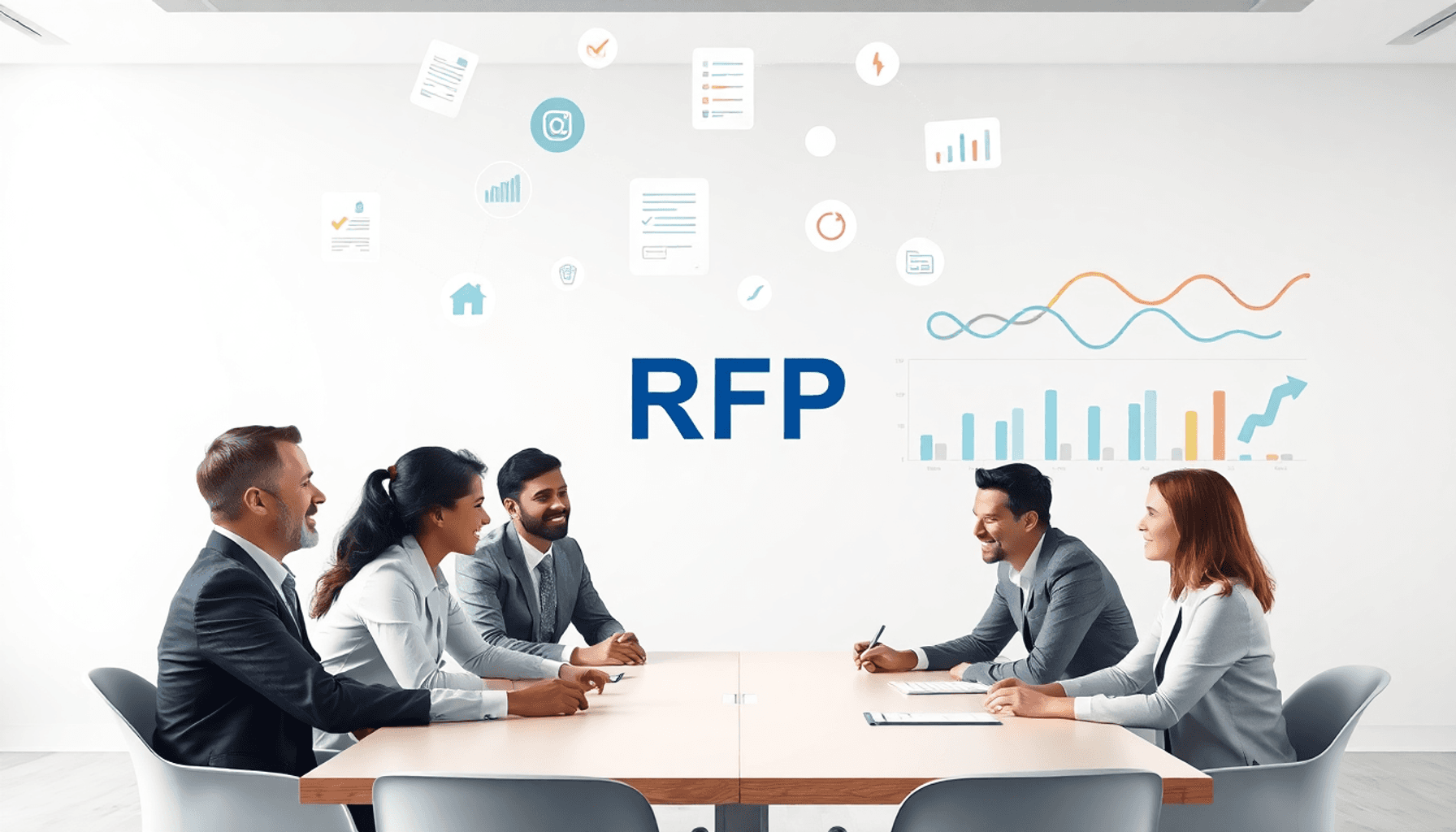Introduction
Indirect spend management refers to the process of overseeing and controlling expenditures that are not directly tied to the production of goods or services. This includes categories such as office supplies, travel expenses, and IT services. Effective management of indirect spend is crucial in procurement processes as it impacts the overall operational efficiency of an organization.
Key Takeaway: Organizations can achieve substantial cost savings and enhance resource efficiency by effectively managing their indirect spend.
In this blog post, you will learn about:
- The definition and components of indirect spend
- Common challenges faced in managing indirect expenditures
- Strategies for improving indirect spend management
- The role of technology and best practices in optimizing procurement processes, including insights on discovering the best procurement software and outsourcing companies
- The significance of diverse suppliers in your indirect procurement strategy
Understanding these elements will empower you to make informed decisions that drive efficiency and cost reduction within your organization. For instance, leveraging technology can significantly streamline your procurement processes, while also considering entry-level procurement jobs which can provide valuable experience in managing these aspects.
Additionally, when dealing with specific categories like healthcare supplies, understanding the essential PPE for airborne precautions can be beneficial. Moreover, exploring options such as purchasing groups versus group purchasing organizations can help optimize your buying strategy.
Lastly, it’s worth noting that some organizations may even explore avenues like maximizing federal grant funding for nonprofits to further enhance their resource efficiency.
Understanding Indirect Spend
Indirect spend refers to non-core expenditures that organizations incur in their daily operations. Unlike direct spend, which relates to the procurement of goods and services directly involved in production, indirect spend encompasses a wide range of purchases that support business functions. This distinction is crucial for managing an organizational budget effectively.
Characteristics of Indirect Spend
- Non-Core Nature: These expenses do not contribute directly to the primary revenue-generating activities.
- Variety: Indirect spend categories can differ significantly across organizations based on their operational needs.
Common Categories of Indirect Spend
-
Office Supplies
Items such as pens, paper, and printer cartridges fall under this category. These are essential for daily operations but do not contribute directly to production outputs. However, investing in quality office supplies can also help in boosting employee morale which indirectly enhances productivity. -
Travel Costs
Expenses related to employee travel, including airfare, lodging, and meals, are classified as indirect spend. While necessary for business development and client engagement, they do not directly impact manufacturing or service delivery. -
IT Services
Services that support technology infrastructure—such as software subscriptions, cloud services, and maintenance—are significant components of indirect spending. They ensure smooth operations but are not tied to product creation. -
Diversity, Equity and Inclusion Initiatives
Expenditures related to implementing Diversity, Equity and Inclusion (DEI) initiatives within the workplace also fall under indirect spend. These initiatives are crucial for fostering a positive work environment and enhancing overall employee satisfaction. -
Supplier Innovation Trends
Keeping abreast with top trends in supplier innovation can also lead to significant cost savings in the indirect spend category by optimizing supplier relationships and procurement processes.
Understanding these categories allows organizations to identify areas where cost savings can be achieved through effective indirect spend management strategies. By gaining clarity on what constitutes indirect spend, businesses can enhance procurement processes and drive significant efficiency improvements throughout their operations.
Challenges in Indirect Spend Management
Managing indirect spend presents several challenges for organizations. Navigating these obstacles effectively is crucial for optimizing procurement processes and achieving significant cost savings.
1. Visibility Issues
A primary challenge stems from a lack of visibility into spending patterns. Without comprehensive data analysis, organizations struggle to identify where money is being spent. This limited insight hampers decision-making and prevents the identification of cost-saving opportunities.
2. Maverick Spending
Uncontrolled purchases, also known as maverick spending, pose another significant issue. Employees might bypass established procurement processes, leading to inconsistent purchasing decisions. This behavior not only inflates costs but can also compromise supplier relationships and result in suboptimal product quality.
3. Negotiation Challenges
Inadequate supplier negotiation strategies further complicate indirect spend management. Organizations may miss out on favorable pricing or terms due to a lack of structured engagement with suppliers. Not leveraging strong relationships can lead to missed opportunities for discounts or bulk pricing.
The combination of visibility issues, maverick spending, and negotiation challenges creates an environment where organizations are unable to effectively manage their indirect spend. Addressing these challenges requires a strategic approach that focuses on improving oversight, enhancing supplier relationships, and establishing clear procurement policies. Implementing such strategies will pave the way for better resource allocation and substantial savings across various categories of indirect spend. Moreover, focusing on maximizing supplier performance can ensure quality and reliability in the products procured, further optimizing the indirect spend management process.
Strategies for Effective Indirect Spend Management
Effective indirect spend management involves implementing several key strategies to optimize purchasing processes.
Create Clear Spending Policies
Establishing spending policies is critical. These guidelines should clearly outline acceptable purchasing practices and procedures. By doing so, you provide employees with a framework for making informed decisions regarding their purchases. This clarity minimizes unnecessary expenditures and fosters accountability.
Establish Approval Workflows
Implementing approval workflows enhances oversight within the procurement process. Consider the following elements:
- Multi-level approvals for higher-value transactions can prevent unauthorized spending.
- Automated notifications ensure that requests are reviewed promptly, maintaining efficiency while safeguarding against maverick spending.
These workflows not only reinforce compliance but also facilitate better decision-making regarding indirect spending.
Build Strong Vendor Relationships
Developing strong relationships with preferred vendors yields significant advantages. Regular communication fosters trust and openness, which can lead to:
- Improved pricing options and terms
- Enhanced service levels tailored to your organization’s specific needs
- Collaborative opportunities for volume discounts based on your purchasing behavior
Leverage Effective Sourcing Strategies
In addition to building vendor relationships, organizations should also consider adopting effective sourcing strategies. These strategies can help in hiring top talent while ensuring that procurement processes are optimized.
Build Resilience in Procurement
It’s essential to build resilience in procurement especially during tough times. This involves having contingency plans in place and being adaptable to changing circumstances.
Address Common Misconceptions in Purchasing
Moreover, organizations should focus on mythbusting common misconceptions related to purchasing, such as those surrounding Group Purchasing Organizations (GPOs).
Communicate Procurement’s Value Effectively
Finally, it’s crucial to avoid certain procurement terms that may hinder effective communication of procurement’s value. By focusing on these strategic areas, organizations can create a robust framework for managing indirect spend effectively. Each strategy contributes to increased visibility, enhanced control over expenditures, and ultimately better financial performance.
Leveraging Technology for Enhanced Spend Management
Technology plays a crucial role in optimizing indirect spend management processes. By adopting advanced tools and software, organizations can significantly improve their procurement efficiency and effectiveness.
Key Benefits of Specialized Spend Management Software
1. Data Automation
Automating data collection and analysis reduces manual errors, enhances accuracy, and provides real-time insights into spending behavior. Automated systems streamline processes, allowing teams to focus on strategic decision-making rather than administrative tasks.
2. Enhanced Reporting Capabilities
Spend management software offers customizable reporting features that enable organizations to visualize spending patterns. This capability aids in identifying trends, monitoring compliance with budgetary constraints, and highlighting areas for potential savings.
3. Compliance Monitoring
Compliance with internal policies and external regulations is critical in indirect spend management. Specialized software facilitates ongoing monitoring of transactions against established guidelines. This ensures that all purchases align with organizational objectives and helps mitigate risks associated with maverick spending.
4. Improved Supplier Management
Technology enables better tracking of supplier performance, fostering stronger relationships. Organizations can analyze supplier data to negotiate better terms and pricing, ultimately leading to cost savings.
5. Integration Capabilities
Spend management solutions often integrate seamlessly with existing financial systems. This connectivity enhances data accuracy across departments, providing a unified view of organizational spending.
Investing in the right spend management software empowers organizations to leverage data automation while driving compliance and enhancing overall procurement strategies. Embracing technology not only simplifies processes but also opens the door to substantial cost savings and improved resource allocation.
For instance, through collective spend, organizations can achieve drastic cost reductions by pooling their purchasing power together.
Moreover, understanding the nuances between strategic sourcing and category management can further enhance procurement strategies. Finally, organizations should consider unlocking exclusive membership benefits that come with certain spend management solutions for added advantages.
Best Practices for Successful Indirect Spend Management
Achieving effective indirect spend management requires a proactive approach, focusing on two key areas: leveraging advanced analytics tools and engaging stakeholders.
Leveraging Advanced Analytics Tools
- Visibility into Spending Patterns: Utilizing advanced analytics tools enables organizations to track spending patterns comprehensively. This visibility helps identify trends, variances, and opportunities for cost savings.
- Data-Driven Decisions: With detailed insights, procurement teams can make informed decisions, optimizing purchasing processes and ensuring that resources are allocated efficiently. Such procurement optimization leads to substantial improvements in overall efficiency.
Engaging Stakeholders
- Cross-Department Collaboration: Involving various stakeholders across the organization fosters alignment with business objectives. Procurement should not operate in isolation; collaboration enhances understanding of needs and priorities.
- Feedback Mechanisms: Establishing channels for feedback from departments ensures that procurement strategies meet the actual requirements of users. Frequent communication aids in adjusting policies to better suit organizational goals.
Engaging stakeholders also promotes a culture of accountability and compliance. When employees understand the significance of managing indirect spend effectively, they are more likely to adhere to established policies.
By integrating advanced analytics and stakeholder engagement into indirect spend management practices, organizations can enhance their procurement strategies significantly. These practices lead not only to cost reductions but also to improved resource utilization across the board.
To further maximize cost savings in daily operations, companies can adopt principles from the art of frugal living. This includes embracing constraints and optimizing processes as suggested in our guide on succeeding with limited resources.
Moreover, understanding compensation trends such as those outlined in our article about procurement engineer salary expectations for 2025 can provide valuable insights for both employees and employers in the procurement sector.
Finally, maintaining transparent supplier communication is crucial for building trust and driving business growth.
The Role of Diverse Suppliers in Indirect Spend Management
Including diverse suppliers in an organization’s indirect procurement strategy is crucial for promoting inclusivity and improving overall business performance. Partnering with suppliers like HUBZone certified businesses and woman-owned enterprises can bring significant benefits to organizations.
Benefits of Including Diverse Suppliers:
- Enhanced Innovation: Diverse suppliers bring unique perspectives and innovative solutions that can lead to improved products and services.
- Community Engagement: Supporting HUBZone businesses contributes to local economies, creating jobs and fostering community development.
- Compliance and Reputation: Engaging with diverse suppliers helps organizations meet compliance requirements while enhancing their reputation as socially responsible entities.
Importance of HUBZone Compliance
HUBZone compliance is crucial for organizations aiming to maximize their indirect spend efficiency. By collaborating with HUBZone certified businesses, companies can:
- Access Competitive Pricing: These suppliers often provide cost-effective solutions, contributing to significant savings on indirect spend categories like office supplies and IT services.
- Unlock Contracting Opportunities: Many government contracts favor organizations that include diverse suppliers, expanding potential business opportunities.
Supporting Woman-Owned Businesses
Supporting woman-owned businesses not only promotes gender equality but also drives economic growth.
Organizations that prioritize woman-owned suppliers in their procurement strategies can expect:
- Diverse Product Offering: Woman-owned businesses often provide a wide range of products and services tailored to meet various needs.
- Strengthened Supplier Relationships: Building strong partnerships with these vendors fosters loyalty and collaboration, ultimately leading to more favorable terms.
Integrating diverse suppliers into indirect spend management strategies not only enriches the supply chain but also aligns with broader organizational goals. The commitment to diversity enhances operational effectiveness while promoting sustainable practices within the procurement process.
To further optimize indirect spend management, organizations can explore advanced strategies like tail spend management. This approach allows for better control over less frequently purchased items, often leading to significant cost savings. Additionally, for those managing a one-person procurement function, strategic solutions from Hubzone Depot can provide valuable insights on cost efficiency and supplier management.
Case Studies: Successful Implementation of Indirect Spend Management Strategies
Real-world examples showcase the effectiveness of successful procurement strategies in managing indirect spend.
Case Study 1: Office Supplies Optimization
A large corporation focused on office supplies faced rising costs. By implementing a Group Purchasing Organization (GPO), they negotiated bulk pricing with suppliers. This strategic approach resulted in:
- Cost Reduction: Achieved an average savings of 25% across office supply purchases.
- Streamlined Processes: Standardized purchasing procedures improved compliance and reduced maverick spending.
Case Study 2: Travel Expense Management
A mid-sized company struggled with unpredictable travel expenses. They established clear travel policies and approval workflows, which included:
- Pre-Approval Requirements: Employees must secure approval before booking travel, leading to more informed decision-making.
- Preferred Vendor Relationships: Collaborating with specific airlines and hotels secured discounts, yielding a 15% reduction in overall travel costs.
Case Study 3: IT Services Consolidation
A public sector organization sought to control its IT service expenditures. By consolidating vendors and enhancing supplier negotiations, they experienced:
- Improved Visibility: Leveraged analytics tools to monitor spending patterns effectively.
- Negotiated Savings: Established long-term contracts with preferred vendors led to a 20% decrease in IT service costs.
These examples illustrate how organizations can achieve significant cost savings while enhancing efficiency through targeted indirect spend management tactics. Each case emphasizes the value of strategic relationships and robust policies in optimizing procurement processes.
Conclusion
Organizations that prioritize maximizing savings opportunities through effective indirect spend management position themselves for long-term success. Implementing strategic practices is essential for optimizing procurement processes. Consider the following steps:
- Evaluate Current Practices: Identify areas of inefficiency in your indirect spend strategies.
- Establish Clear Policies: Develop guidelines that empower employees while maintaining control over spending.
- Leverage Technology: Utilize specialized software to gain insights and enhance compliance.
The journey toward efficient indirect spend management requires commitment and proactive measures. By focusing on these strategies, organizations can not only reduce costs but also enhance resource efficiency. Taking decisive action in this area leads to sustainable benefits, supporting both the bottom line and operational effectiveness.
Moreover, embracing a mindset of continuous learning and adaptation can significantly enhance procurement success. As highlighted in Frank Corris’s transformative journey, mastering procurement through learning and strategic thinking is key. Embrace the opportunity to improve your indirect procurement practices today.
FAQs (Frequently Asked Questions)
What is indirect spend management?
Indirect spend management refers to the process of overseeing and controlling non-core expenditures within an organization, such as office supplies, travel costs, and IT services. It is significant in procurement processes as it can lead to substantial cost savings and enhanced resource efficiency.
What are some common challenges in managing indirect spend?
Common challenges include visibility issues that hinder understanding of spending patterns, maverick spending where uncontrolled purchases occur outside established guidelines, and difficulties in negotiating favorable terms with suppliers.
How can organizations improve their indirect spend management?
Organizations can improve their indirect spend management by creating clear spending policies, establishing approval workflows for purchases, and building strong relationships with preferred vendors to negotiate better pricing and terms.
What role does technology play in indirect spend management?
Technology plays a crucial role in optimizing indirect spend management processes by utilizing specialized spend management software for data analysis, reporting, and ensuring compliance. This allows organizations to make informed decisions based on accurate data.
Why is stakeholder engagement important in indirect spend management?
Engaging various stakeholders across the organization is essential as it ensures alignment with business objectives and promotes collaboration. This collective approach helps identify savings opportunities and improves overall procurement effectiveness.
What is the significance of including diverse suppliers in indirect spend management?
Including diverse suppliers, such as HUBZone certified businesses and woman-owned enterprises, in an organization’s procurement strategy enhances supplier diversity. It not only supports community growth but also fosters innovation and competition among suppliers.






